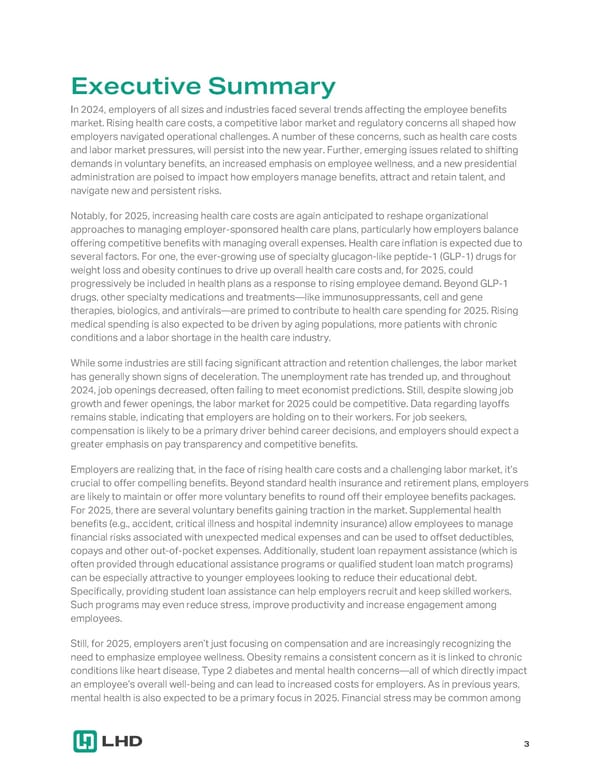Executive Summary In 2024, employers of all sizes and industries faced several trends affecting the employee benefits market. Rising health care costs, a competitive labor market and regulatory concerns all shaped how employers navigated operational challenges. A number of these concerns, such as health care costs and labor market pressures, will persist into the new year. Further, emerging issues related to shifting demands in voluntary benefits, an increased emphasis on employee wellness, and a new presidential administration are poised to impact how employers manage benefits, attract and retain talent, and navigate new and persistent risks. Notably, for 2025, increasing health care costs are again anticipated to reshape organizational approaches to managing employer-sponsored health care plans, particularly how employers balance offering competitive benefits with managing overall expenses. Health care inflation is expected due to several factors. For one, the ever-growing use of specialty glucagon-like peptide-1 (GLP-1) drugs for weight loss and obesity continues to drive up overall health care costs and, for 2025, could progressively be included in health plans as a response to rising employee demand. Beyond GLP-1 drugs, other specialty medications and treatments—like immunosuppressants, cell and gene therapies, biologics, and antivirals—are primed to contribute to health care spending for 2025. Rising medical spending is also expected to be driven by aging populations, more patients with chronic conditions and a labor shortage in the health care industry. While some industries are still facing significant attraction and retention challenges, the labor market has generally shown signs of deceleration. The unemployment rate has trended up, and throughout 2024, job openings decreased, often failing to meet economist predictions. Still, despite slowing job growth and fewer openings, the labor market for 2025 could be competitive. Data regarding layoffs remains stable, indicating that employers are holding on to their workers. For job seekers, compensation is likely to be a primary driver behind career decisions, and employers should expect a greater emphasis on pay transparency and competitive benefits. Employers are realizing that, in the face of rising health care costs and a challenging labor market, it’s crucial to offer compelling benefits. Beyond standard health insurance and retirement plans, employers are likely to maintain or offer more voluntary benefits to round off their employee benefits packages. For 2025, there are several voluntary benefits gaining traction in the market. Supplemental health benefits (e.g., accident, critical illness and hospital indemnity insurance) allow employees to manage financial risks associated with unexpected medical expenses and can be used to offset deductibles, copays and other out-of-pocket expenses. Additionally, student loan repayment assistance (which is often provided through educational assistance programs or qualified student loan match programs) can be especially attractive to younger employees looking to reduce their educational debt. Specifically, providing student loan assistance can help employers recruit and keep skilled workers. Such programs may even reduce stress, improve productivity and increase engagement among employees. Still, for 2025, employers aren’t just focusing on compensation and are increasingly recognizing the need to emphasize employee wellness. Obesity remains a consistent concern as it is linked to chronic conditions like heart disease, Type 2 diabetes and mental health concerns—all of which directly impact an employee’s overall well-being and can lead to increased costs for employers. As in previous years, mental health is also expected to be a primary focus in 2025. Financial stress may be common among 3
 2025 Employee Benefits Market Outlook Page 2 Page 4
2025 Employee Benefits Market Outlook Page 2 Page 4